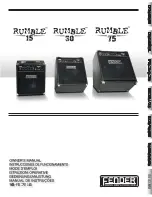
6-14 Circuit
Descriptions
SR844 RF Lock-In Amplifier
CMXC: Chop Circuit
This section generates the chopped Local Oscillator signals that are used by the Mixer
section to downconvert the input signal from the Reference frequency (25kHz
-
200MHz) to the Intermediate Frequency (I. F. : 2 – 3 kHz and 8 – 12 kHz).
U713 generates the appropriate chopping signal by dividing down the 49–98 kHz divider
chain output. The division is performed as follows :
RANG4C
TCMIN
Divisor
Comment
0 0
12
Bottom half of octave and long time constant,
I.F. = 2–3 kHz
0 1
3
Bottom half of octave and short time constant,
I.F. = 8–12 kHz
1 0
16
Top half of octave and long time constant,
I.F. = 2–3 kHz
1 1
4
Top half of octave and short time constant,
I.F. = 8–12 kHz
The chop output U713.15 is a symmetric square wave. It is buffered by U714 and then
converted to ECL levels by the network R714–716. The other output of U713 is a sync
output which is high for a length of time equal to one data sample period; this signal
allows the DSP to ensure that the demodulation it applies is in phase with the chopping
waveform.
U707 is used to synchronize the ECL chop waveform to the 6–12 MHz divider chain
output. U705 buffers the Reference Frequency output from the divider chain. These two
signals are XOR’ed by U708; when the chop (
A
) input is low the
Q
output of U708 is
equal to the reference frequency (
B
) input. When the chop (
A
) input is high, the
Q
output
is the inverse of the
B
input. Thus the output of U708 is a signal at the reference
frequency that has been chopped at the I.F.
U702 buffers the divider chain output at twice the reference frequency (
2FR
). The
outputs are wired to the flip-flops U709 and U710 with opposite phase, so that U709
clocks on a rising edge of
2FR
while U710 clocks on a falling edge of
2FR
. This is a
180
°
phase difference at twice the reference frequency, which is 90
°
phase difference at
the reference frequency. Since the
D
inputs to U709 and U710 are the same except for
one being the inverse of the other, the outputs of U709 and U710 are identical except for
a 90
°
phase shift – which is exactly what is required for in-phase and quadrature mixing.
These are the local oscillator signals that are fed to the mixer section (
XDRV
±
, YDRV
±
).
These signals return back to the chop section (
XRET
±
, YRET
±
) for termination.
CMXM: Mixers
The inputs to the mixer section are (1) the conditioned input signal from the Signal board
84SIG, and (2,3) the Local oscillator inputs from the Chop section above. The outputs of
this section are filtered I.F. signals,
MIXX
and
MIXY
for the In-Phase and Quadrature
channels respectively. The operation of the In-Phase channel X mixer is described
below; the operation of the Quadrature or Y channel is identical.
Содержание SR844
Страница 10: ...viii SR844 RF Lock In Amplifier...
Страница 12: ...1 2 Getting Started SR844 RF Lock In Amplifier...
Страница 32: ...2 2 SR844 Basics SR844 RF Lock In Amplifier...
Страница 60: ...3 2 Operation SR844 RF Lock In Amplifier...
Страница 102: ...3 44 Shift Functions SR844 RF Lock In Amplifier...
Страница 108: ...4 6 Index of Commands SR844 RF Lock In Amplifier...
Страница 144: ...4 42 Example Program SR844 RF Lock In Amplifier...
Страница 146: ...5 2 Performance Tests SR844 RF Lock In Amplifier...
Страница 150: ...5 6 Performance Tests SR844 RF Lock In Amplifier...
Страница 156: ...5 12 Performance Tests SR844 RF Lock In Amplifier...
Страница 158: ...5 14 Performance Tests SR844 RF Lock In Amplifier...
Страница 162: ...5 18 Performance Tests SR844 RF Lock In Amplifier...
Страница 166: ...5 22 SR844 Test Record SR844 RF Lock In Amplifier...
Страница 168: ...6 2 Circuitry Parts Lists and Schematics SR844 RF Lock In Amplifier...
Страница 246: ...Parts Lists SR844 RF Lock In Amplifier 6 80 Schematic Diagrams...















































